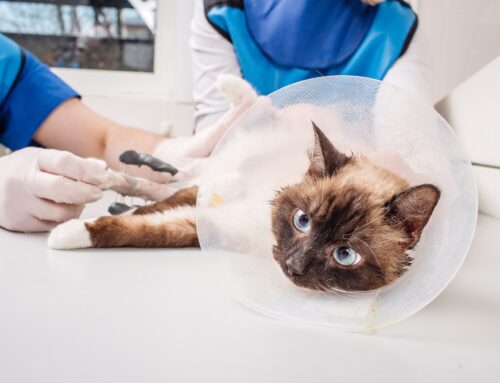Springtime Danger: How to Protect Your Pet from Foxtails
If you’re a pet owner in Spring Branch, TX, chances are you’ve spent many lovely afternoons strolling through our local parks and trails with your dog. But while you’re soaking up the sunshine, your pet could be encountering something far less pleasant- foxtails. These tiny grass awns may not look dangerous, but they can cause major health issues for pets. At Spring Branch Veterinary Hospital, we want to make sure you know what to look for and how to protect your pet during foxtail season.
What Are Grass Awns (Foxtails)?
Foxtails are the barbed seed heads of certain grasses, shaped like tiny spears with backward-facing barbs. Their natural purpose is to latch onto surfaces and spread the plant’s seeds. Unfortunately, this design makes them perfect for burrowing into fur, skin, and even internal tissues.
The grasses that produce foxtails are common in our area. If you’ve walked your dog through a field or an overgrown lot lately, you’ve likely seen them without realizing the risk.
Why Are Foxtails Dangerous?
Once a foxtail attaches to your pet, it doesn’t stop there. The barbs make it easy for the seed to keep moving forward- and nearly impossible to back out. That means the foxtail can penetrate skin, burrow deep into tissue, and even migrate internally.
According to the AKC, foxtails have been found in the lungs, brain, and other organs. What starts as a small irritant can quickly escalate to a serious medical concern.
How Do Foxtails Enter the Body?
Foxtails can find their way in through several common entry points:
- Skin: Often between the toes or under the armpits, leading to swelling and redness.
- Nose: Sudden sneezing, pawing at the face, or nasal discharge may follow.
- Ears: Head shaking, tilting, or signs of ear pain are red flags.
- Eyes: Tearing, squinting, or visible irritation can indicate an awn in the eye.
- Paws: Limping or licking at the feet might signal a lodged awn.
Once embedded, foxtails often migrate deeper, carrying bacteria and triggering infections, abscesses, or even more severe complications.
Recognizing the Signs: When to Be Concerned
The earlier you detect a foxtail, the easier it is to treat. Keep an eye out for:
- Sudden sneezing or nasal discharge
- Limping or excessive paw licking
- Head shaking or ear scratching
- Red, swollen areas on the body
- Visible pus or discharge
If your pet seems “off” after a walk- especially if you’ve been in grassy areas- it’s worth checking them over carefully.
Diagnosing Foxtail Injuries at the Vet
At Spring Branch Veterinary Hospital, we perform a thorough physical exam and use diagnostic tools as needed. Depending on the symptoms, this may include:
- Otoscope exam for ears
- Cytology to check for infection
- X-rays or ultrasound to locate deep-seated foxtails
Not all foxtails are easy to spot. Some are tiny and fully buried beneath the skin, which is why accurate diagnostics are essential.
Treatment Options
Conservative Treatment
When caught early, treatment may be simple:
- Manual removal of visible foxtails
- Cleaning and disinfecting the affected area
- Antibiotics to prevent or treat infection
More Advanced Care
For more serious or internal cases, we may recommend:
- Endoscopy: A minimally invasive option for retrieving foxtails from the nose or throat
- Exploratory surgery: Needed if the foxtail has migrated deep into tissue
- Wound drainage and abscess management
Follow-up appointments help ensure the entire awn has been removed and that healing is progressing well.
Risks of Ignoring the Problem
Delaying treatment can lead to:
- Chronic infections or abscesses
- Damage to internal organs
- Pneumonia if awns reach the lungs
- Long-term discomfort or mobility issues
What may look like a small scratch today could turn into a surgical emergency if a foxtail has migrated internally.
How Grass Awn Injuries Affect Daily Life
Aside from the medical risks, foxtails can take a toll on both you and your pet:
- Pain and irritation can change your pet’s behavior
- Repeated vet visits can strain your time and finances
- Activity restrictions during recovery can be frustrating for energetic pets
The good news is that prevention goes a long way- and that’s where we come in.
How to Prevent Foxtail Injuries
Avoid High-Risk Areas
Stick to well-groomed paths and avoid overgrown trails or fields, especially in spring and summer. For more strategies, visit Preventing and Treating Foxtail Injuries to Dogs.
Routine Grooming and Daily Checks
- Brush your pet regularly, especially after outdoor activities
- Check between toes, under legs, inside ears, and around the eyes and mouth
- Bathing can help dislodge any hidden foxtails
Learn more about grooming benefits at Why Pets Need Regular Grooming.

Use Protective Gear
For dogs prone to foxtail injuries, consider using:
- Boots to protect paws
- Mesh headgear or snoods to shield ears and eyes
These may not be stylish, but they can save you from serious health problems down the road.
At-Home Tips: What You Can Do Between Vet Visits
- Inspect thoroughly after each walk
- Document symptoms with photos or videos to share with your vet
- Keep fur trimmed around the ears and paws to help discourage awns attaching
What to Expect at Your Veterinary Appointment
When you come in for a foxtail concern, bring:
- A clear timeline of when symptoms started
- Any visible discharge or debris (in a sealed container if needed)
- Video or photo documentation of symptoms
Questions to ask your vet may include:
- What are the next steps for diagnosis and treatment?
- How can I support my pet’s healing at home?
- How can I prevent this from happening again?
FAQs About Grass Awns
How can I tell if my pet has a foxtail?
Sneezing, limping, licking, and sudden behavior changes after being outdoors are common signs.
Are foxtails dangerous for all pets?
Yes, but pets with long hair or floppy ears may be more at risk.
Can foxtails be fatal?
Although rare, untreated foxtails can lead to serious or life-threatening complications.
Your Local Team for Foxtail Season
Foxtails are sneaky, but you’re not in this alone. At Spring Branch Veterinary Hospital, we’re ready to help you prevent problems before they start- or treat them quickly if they arise. If you’re concerned about a possible foxtail injury or want to know how to better protect your pet, contact us or schedule an appointment. We’re here to keep your adventures safe and your pet comfortable all year long.









Leave A Comment